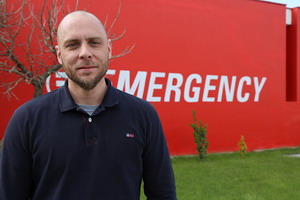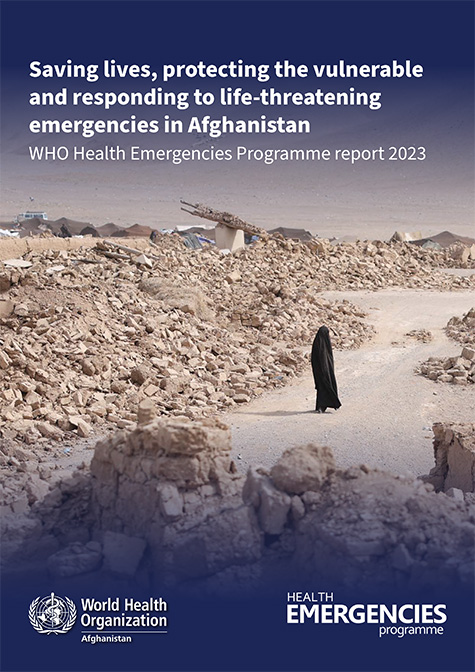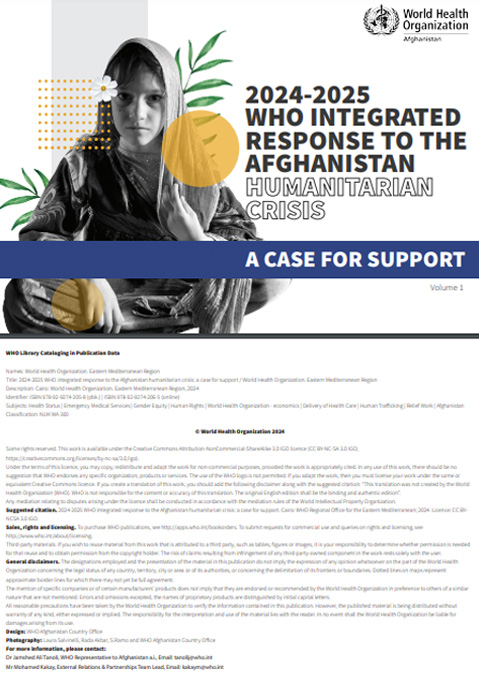Emergency, an Italian humanitarian NGO financially supported by WHO, runs a surgical ward in the centre of Kabul. They treat victims of war for free. Programme coordinator Dejan Panic talks about his work.
7 April 2018 – I Emergency Programme coordinator Dejan Panict was a sunny winter day in one of central Kabul’s busiest areas. Buzzing with shoppers and commuters going about their daily business, the area is part of Kabul’s so-called ring of steel, a heavily fortified area with checkpoints, blast walls and barbed wire protecting the many embassies and government offices.
Emergency Programme coordinator Dejan Panict was a sunny winter day in one of central Kabul’s busiest areas. Buzzing with shoppers and commuters going about their daily business, the area is part of Kabul’s so-called ring of steel, a heavily fortified area with checkpoints, blast walls and barbed wire protecting the many embassies and government offices.
The legendary Chicken Street, full of carpet and souvenir shops, used to be a hotspot for foreign visitors, but now expats have largely deserted the place due to the ever growing insecurity.
At one of the many checkpoints in the city, police officers stopped a vehicle to check it as part of their everyday duties. In a blink of an eye, around 100 people lost their lives, and many more suffered injuries, when explosives hidden in the vehicle were detonated. Later, reports stated that the car was painted like an ambulance, claiming to be taking patients to a hospital.
“3 minutes later, the first patient came in”, remembers Dejan Panic. He works as a programme coordinator for a surgical hospital located a few blocks away from the blast scene in central Kabul. “In 20 minutes the hospital was full”.
Emergency, the Italian NGO supported financially by WHO, who runs one hospital in Kabul and two other hospitals in Panjshir and Hilmand, have seen many large scale attacks, but this was one of their biggest challenges so far.
The hospital has 118-120 ward places, but on that single day, 27. January 2018, 143 patients entered the hospital compound: much more than their maximum capacity, in addition to the patients who were already inside. The injured had to be laid down in the grass outside for triage assessment, before being admitted to surgery. Altogether, the hospital admitted 63 patients. 15 people were brought in dead.
“I don’t know how we survived”, Panic says. “Most stable patients were being placed in the laundry drying room to make space.”
Always prepared
 Nurses in the Emergency hospital. Photo: Tuuli HongistoAn attack like the January ambulance bombing requires quick reaction.
Nurses in the Emergency hospital. Photo: Tuuli HongistoAn attack like the January ambulance bombing requires quick reaction.
“Any time we get a report about a blast, we prepare for a mass casualty incident”, Panic explains.
“The hospital stops daily routine: we finish any ongoing operations and other activities quickly, move stable patients to make space for newly injured patients and check that we have the triage area and equipment ready. All staff members are assigned to a work station where they wait for instructions.”
These situations can be stressful even for a seasoned professional. Panic has worked in Afghanistan for 8 years, since 2010, first as a surgical nurse, then later as a field officer and medical coordinator. Now he is in charge of the operations of three hospitals and several first aid posts. “Even with the medical training I have, I sometimes question my abilities”.
“I remember when I saw my first patients in Kabul, after having just arrived in the country. Three people came in after a gas cylinder had exploded in Shahr-e Naw. They were severely burned and it was shocking. My older colleague looked at me and said: ‘welcome to Afghanistan’. Those words were carved into my mind”.
Child of war
Panic knows what it is like to live in a war zone. He grew up in the middle of the Yugoslavian ethnic conflict, and has seen the burden civilians bear. His family comes from Novi Sad, an area which received one of the largest influxes of refugees during the war.
“I remember trucks carrying old people and children in tears – they didn’t even know where they were going. Many had left with nothing but the clothes they were wearing. In a few months, we had gone from one country with shared sporting events to mass graves and burnt villages. I didn’t understand why. This is when I developed a motivation of wanting to help people.”
Emergency has worked in Afghanistan since 1999, when the organization opened its first surgical centre. Both the intensity of the conflict and the severity of the injuries has gone up in recent years, and Panic has experienced the effects first hand.
“One of our doctors in Helmand said that Afghans are improving in the wrong way: making bigger and more destructive bombs. What would had been seen as the severe cases when I arrived in 2010, would now be seen as minor injuries. Now we see terrible injuries such as bilateral and triple amputations. The workload has also increased: the number of admissions between 2010 and now has been going up by around 15% every year.”
Often, the hospital is full, and the staff are faced with difficult choices. “We cannot treat everyone, but it is difficult to turn anyone away. We try to always help the most serious cases, as we know they have very limited access to healthcare outside”.
Anyone who comes through the gate will be treated for free. “I strongly believe that everybody should have the right to be treated free of charge as a right of birth.”
2017 was Emergency’s busiest year so far, with overall 3400 patients admitted.
Green oasis
In the middle of war-torn Kabul, the garden inside the hospital compound is like a green oasis, blooming with spring’s first flowers. “We wanted to make the hospital surroundings calm and peaceful. After suffering, people should be able to regain a piece of their dignity”, Panic explains.
 Salim is one of the patients treated for a gunshot wound in the Emergency hospital. He had to walk for two hours with the bullet injury before reaching care, but received urgent surgery in Kabul. Photo Tuuli HongistoThe peaceful atmosphere is in stark contrast to the trauma many of the patients have experienced. Inside the hospital, surgeons can be seen through a window working in the operations theatre to help a young girl shot in the head. In the sub-intensive care unit, there are stabbing victims, a boy who was hit by a mine, and young men with bullet holes in their chest and abdomen. In the children’s ward, a little girl has had both of her legs amputated on the previous day – and in the next room, an adult man is starting his third month in the hospital. He was one of the ambulance bombing victims, and has a long way ahead to recovery.
Salim is one of the patients treated for a gunshot wound in the Emergency hospital. He had to walk for two hours with the bullet injury before reaching care, but received urgent surgery in Kabul. Photo Tuuli HongistoThe peaceful atmosphere is in stark contrast to the trauma many of the patients have experienced. Inside the hospital, surgeons can be seen through a window working in the operations theatre to help a young girl shot in the head. In the sub-intensive care unit, there are stabbing victims, a boy who was hit by a mine, and young men with bullet holes in their chest and abdomen. In the children’s ward, a little girl has had both of her legs amputated on the previous day – and in the next room, an adult man is starting his third month in the hospital. He was one of the ambulance bombing victims, and has a long way ahead to recovery.
This is what Afghanistan looks like – and will look like for the years to come.
“I don’t see that the conflict will scale down in the near future”, Panic says and shakes his head. “It looks like this year will be busier than the last”.
He hopes that the Afghans can one day run the hospitals. Emergency trains medical professionals, and Panic is very proud when he says that “a generation of trauma surgeons are coming out of the Emergency school benches”. So far, two gynecologists, and 14 surgeons have graduated, and further 30 students are being trained in general and trauma surgery, pediatrics and gynecology and obstetrics.
“If I was injured, I would want to be operated by the Afghans. We have incredible senior surgeons. In Europe, we would have several specialized teams working on treating the complex trauma cases as we see here, but here one surgeon has to manage.“
Legacy of war
 Bashir Momand (left) is a junior surgeon in Emergency hospital and Habib Habibi is one of the most experienced nursesEven though the hospital treats the physical wounds, Panic knows that people will be traumatized. “We don’t offer professional psychosocial support counselling, although human compassion is very high between the staff and the patients. Our common aim is to have as many patients alive as possible, but they have to go back into the real world after they leave.”
Bashir Momand (left) is a junior surgeon in Emergency hospital and Habib Habibi is one of the most experienced nursesEven though the hospital treats the physical wounds, Panic knows that people will be traumatized. “We don’t offer professional psychosocial support counselling, although human compassion is very high between the staff and the patients. Our common aim is to have as many patients alive as possible, but they have to go back into the real world after they leave.”
Sometimes the team hears happy news after treating a patient. “This morning, I came across a story of one of our patients in the Guardian. The woman had been shot in the face. I remember her, it was very severe and she stayed in our hospital for 69 days. I was happy to hear that she was rebuilding her life.”
Panic knows from personal experience that the effects of war will last for a long time after fighting ends. “In Serbia, one of my best friends just had their grandfather buried this year. He had been killed in 1994 or 1995 in Croatia, and was found in a mass grave. He was brought back home for burial.”
But there is always hope.
“The war destroyed the futures of many, but some people were able to build a life. Our family always tried to help as much as we could, my father especially. He always emphasized, that although people had lost material possessions, they had to fight for a better life – and not with guns. Now, years later, we get letters from for example Australia, thanking for the help: getting people out of the refugee camps and on their feet. This brings tears in my father’s eyes.”
“Helping others – It matters.”
***
Emergency
WHO-supported organization Emergency has been providing trauma care in Afghanistan since 1999. The Emergency Centre in Kabul has 3 operating rooms, an intensive care unit, a sub-intensive care unit and 6 wards for patients. In addition to being a reference point for the Kabul population and neighboring provinces, the centre welcomes incoming patients from remote areas, also thanks to the only free CT unit in the country. Emergency is funded by WHO, Common Humanitarian Fund (CHF) and ECHO in addition to private individual donors.
Text and photos: Tuuli Hongisto / WHO Afghanistan













